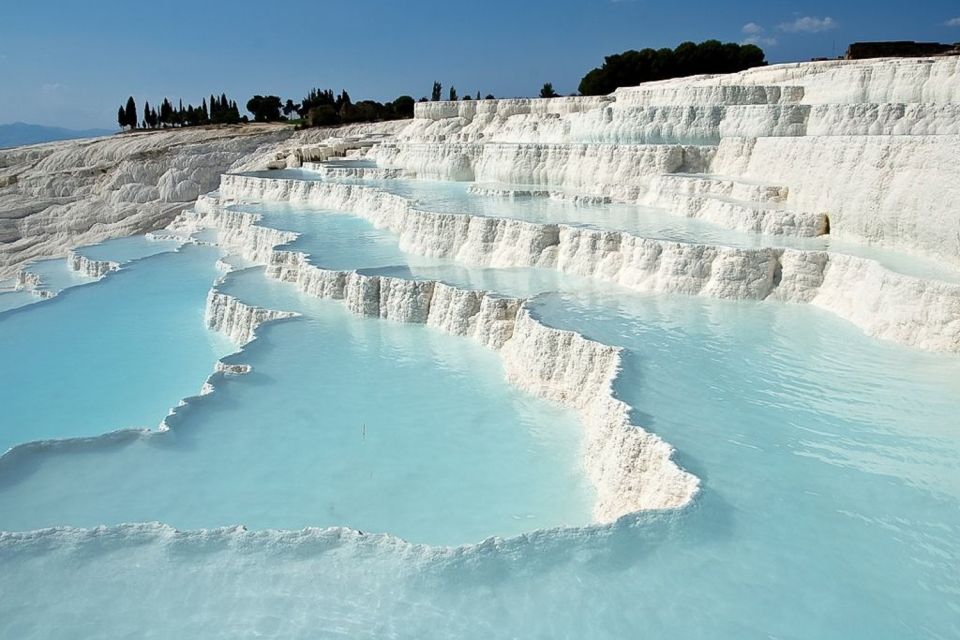1 Day
Up to 5 days
15 people
English, Espanol

Experience one of Turkey’s most visited and popular tourist destinations and historical sites during a day trip to Pamukkale (situated in the Aegean Denizli region, western Turkey), with its white stone wonderland, the ancient Roman baths, Cleopatra’s Pool, thermal spring having therapeutic powers and the Amphitheatre, Hieropolis World Heritage Site.
Pamukkale Travertenleri, also known as the Pamukkale Travertines, is a stunning natural wonder located in Denizli Province, southwestern Turkey. The name “Pamukkale” translates to “Cotton Castle,” which reflects the unique appearance of the area, where white calcium-rich terraces resemble cascading cotton layers.
* Explore and enjoy the white cotton castles of Pamukkale, famous for its thermal spring water plunging down the mountainside and creating a fantastic natural formation of stalactites, cataracts, and basins.
* Enjoy the white terraces, travertines, pools, and castle-like formations.
* Swim at the famous Roman-built Cleopatra’s Pool, which is one of the many ancient Roman baths in the region.
* Admire the archaeological city of Hierapolis, with its Amphitheatre, Hieropolis World Heritage Site, temples, theaters, and the famous necropolis of 1,200 tombs.
* Enjoy the famed carpet workshops, experience the craft of Turkish carpet weaving, and buy or try to make your quality carpets.
Discover the beauty of Pamukkale’s stalactites, waterfalls, and basins.
See the ruins of Hierapolis including the Roman theater and baths.
Soak in the therapeutic thermal waters.
Pamukkale is closely tied to the ancient city of Hierapolis, a UNESCO World Heritage Site founded by the Phrygians in the 2nd century BCE.
Pamukkale has been a place of healing, worship, and relaxation for centuries. It exemplifies the intersection of nature and human history, with its stunning natural formations complementing the ruins of an ancient city.
Today, it continues to captivate visitors from around the world with its beauty and historical significance.
Pamukkale is famous for its white travertine terraces formed by mineral-rich thermal waters and the ancient city of Hierapolis, which is a UNESCO World Heritage Site.
A full-day tour usually lasts 8–10 hours, including travel time if departing from nearby cities like Denizli, Kusadasi, or Antalya.
Yes! Many one-day tours are designed to cover the key attractions, including Hierapolis, the travertines, and Cleopatra’s Pool.
Yes, but only in designated areas to protect the delicate formations. Shoes are not allowed, so you must walk barefoot.
You can wade in some of the travertine pools, but full swimming is not allowed. For swimming, Cleopatra’s Antique Pool is available.
Yes, bring a swimsuit and towel if you plan to swim in Cleopatra’s Pool or explore Karahayıt’s thermal springs.
Spring (April-May) and autumn (September-October) offer pleasant weather, while summer can be very hot. Winter is also a good time if you enjoy cooler temperatures and fewer crowds.
Yes, but bring sunscreen, sunglasses, and a hat, as the white travertines reflect sunlight and can make the area feel hotter.
Yes, it’s family-friendly. Kids will enjoy walking on the travertines and swimming in Cleopatra’s Pool.
Certain areas, such as the travertines, may be challenging for wheelchairs. However, parts of Hierapolis can be explored with assistance.
Yes, optional activities like swimming in Cleopatra’s Pool require a separate fee (approximately 150–200 TRY).
Leave a review